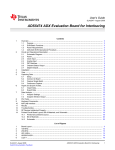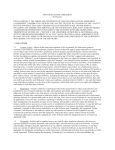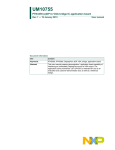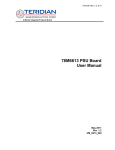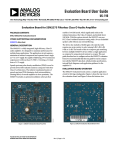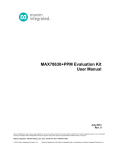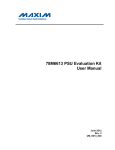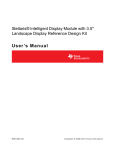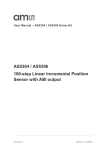Download Remote Control Reference Design nRD24H1 User Guide
Transcript
Remote Control Reference Design nRD24H1 User Guide All rights reserved. Reproduction in whole or in part is prohibited without the prior written permission of the copyright holder. December 2006 User Guide Liability disclaimer Nordic Semiconductor ASA reserves the right to make changes without further notice to the product to improve reliability, function or design. Nordic Semiconductor ASA does not assume any liability arising out of the application or use of any product or circuits described herein. Life support applications These products are not designed for use in life support appliances, devices, or systems where malfunction of these products can reasonably be expected to result in personal injury. Nordic Semiconductor ASA customers using or selling these products for use in such applications do so at their own risk and agree to fully indemnify Nordic Semiconductor ASA for any damages resulting from such improper use or sale. Contact details For your nearest dealer, please see http://www.nordicsemi.no Receive available updates automatically by subscribing to eNews from our homepage or check our website regularly for any available updates. Main office: Otto Nielsen’s vei 12 7004 Trondheim Phone: +47 72 89 89 00 Fax: +47 72 89 89 89 www.nordicsemi.no Revision History Date December 2006 Revision 1.0 Version 1.0 Page 2 of 21 Description Remote Control Reference Design Contents 1 2 3 3.1 3.1.1 3.2 3.3 3.3.1 3.4 4 4.1 4.2 4.3 5 5.1 5.2 5.3 5.4 5.5 5.6 5.7 Introduction ................................................................................................. 4 System Overview ........................................................................................ 4 Hardware Description.................................................................................. 6 RF Module............................................................................................ 6 Specifications ................................................................................... 8 Application Board ................................................................................. 8 USB Receive Dongle ........................................................................... 10 Specifications ................................................................................... 11 nRF24L01 Samples ............................................................................. 11 Hardware Design Guidelines ...................................................................... 12 RF Module............................................................................................ 12 Application Board ................................................................................. 12 USB Receive Dongle ........................................................................... 13 Appendix ..................................................................................................... 14 Bill Of Materials (BOM) ........................................................................ 14 Application board schematics .............................................................. 16 USB receive dongle schematics .......................................................... 17 RF module schematics......................................................................... 18 Design layout for application board ...................................................... 19 Design layout for USB receive dongle ................................................. 20 Design layout for the RF module.......................................................... 21 Revision 1.0 Page 3 of 21 User Guide 1 Introduction nRD24H1 is a reference design for the nRF24L01 general purpose radio chip. The purpose of this document is to help with the design of RF based remote controls operating in the worldwide 2.4GHz ISM band. Based on this reference design you will be able to design one-way and two-way remote controls that are not limited by line-of-sight conditions. This reference design also provides valuable design suggestions for other applications with comparable data rates. 2 System Overview The reference design consists of complete design files (schematics, layout, Gerber, BOM data and source code) for a USB receive dongle, an RF module and, an application board. The remote control unit consists of the RF module and application board. The RF module contains all critical parts and the application board is easily redesigned for the form factor of the finished product. MCU MOSI MISO SCK CSN nRF24L01 CE INT Buttons or GP I/O Figure 1. Block diagram of the remote control unit The USB receive dongle may be used as-is with no hardware changes. The USB receive dongle and remote control unit are not supplied with plastic housing. USB MCU MOSI MISO SCK CSN nRF24L01 CE INT Figure 2. Block diagram of the USB receive dongle You can download the design files from Nordic Semiconductor at www.nordicsemi.no. Revision 1.0 Page 4 of 21 Remote Control Reference Design It is assumed that the USB receive dongle is permanently on while the PC it is plugged into is on. The USB receive dongle goes to a low power mode when the PC is in standby. Only the remote control unit is optimized for long battery life. Revision 1.0 Page 5 of 21 User Guide 3 Hardware Description This section describes the hardware units that are supplied with the nRD24H1. 3.1 RF Module In most applications, redesigning the RF module is not required. The RF module includes the nRF24L01 radio IC and all its supporting components, that is, antenna, matching network and crystal. The RF module also contains a microcontroller. The circumference of the RF module holds GPIO pins of the MCU. The choice of pins enables the RF module to support several different IO standards: • • • • 14 pins for matrix scan of 49 keyboard buttons + 1 LED output. SPI master interface + 14 GPIO pins. Two GPIO pins may alternatively be used for a 2-wire interface (master or slave). Two GPIO pins may alternatively be used for a UART interface. Figure 3. RF module The nRF24L01 radio IC uses a differential antenna interface for both receive and transmit. Connected to this interface are a balun (balanced/unbalanced) and a matching network. The nRF24L01 needs very few external components. A resistor is used for biasing while two small capacitors are sufficient for decoupling. The nRF24L01 also needs an external 16MHz crystal for time reference. The radio is tolerant of ±60ppm crystals, but the RF module is equipped with a ±10ppm crystal because this is the most common tolerance for a crystal of this size. The Atmel ATmega88 MCU is rich in hardware IO features while consuming little power. The MCU on the RF module is programmed from a header on the Application board. The MCU has a 4kbyte program memory and an internal RC oscillator running on 1MHz. Tools from Atmel are necessary to reprogram the MCU. Revision 1.0 Page 6 of 21 Remote Control Reference Design Pin 1 2 3 4 5 6 7 8 9 10 11 12 13 14 15 16 17 18 19 20 21 22 23 24 Name GND PD7 PC0 PC1 PC4 PC5 PB4 PB5 GND PC2 PB3 VCC PC6 PD0 PD1 GND PC3 PD3 PD4 PB6 PD5 PD6 PB2 GND Alternate function LED2 RX data VOL - / SDA VOL UP / SCL MISO SCK MOSI RESET TX data STOP PLAY FORWARD BACK LED1 Table 1. RF module pinout Note: The PB2 pin of the Atmel ATmega88 MCU has special functionality. This pin may not be used as a general purpose input pin in the current design. We recomend that you limit its use to one of the following: • Not connected (as is the case with the present Application Board) • General-purpose output pin for a LED etc. • SPI slave select for devices on your custom Application Board • SPI slave select for the MCU in case devices on your custom Application Board need this communication mode with the MCU. For more information, please consult the Atmel datasheet. The RF module has an operating range from 1.9 to 3.6V. Revision 1.0 Page 7 of 21 User Guide 3.1.1 Specifications Operating conditions Supply voltage Current consumption Status Range 1.9 - 3.6 V 20µA with brownout detection at 3 V supply. 1.2µA without brownout detection. 15 mA peak at 3 V supply 2402-2478 MHz 0 dBm Idle Peak current Radio frequency Output power Table 2. Electrical Specifications PCB type PCB dimension Length x width x height 1.6 mm 2 layer FR4 39 mm x 17 mm x 1.6 mm Table 3. Physical Specifications 3.2 Application Board While the RF module can be used as-is in a vast number of applications, the application board is made with redesign in mind. It is hard to anticipate all the different form factors that end products based on nRD24H1 may have. But, the most likely hardware differences will be in casing, button placement, display design and power management. We have not considered the casing design at all, but the rest of the application board should be very easy to redesign. The Application board that ships with nRD24H1 contains the following units: • • • • • • • Footprint for the RF module Six buttons Batteries External power connector Programming header for the MCU on the RF module Two LEDs Debug pins for application development The power switch S7 can be used in conjunction with the batteries or the external power connector. You should use either batteries or external power. External power on (batteries off) is selected with the switch pointing down while batteries on (external power off) is selected with the switch pointing up. Note: It is important to keep the voltage supply within the 1.9 to 3.6V limits. There is no over voltage protection circuitry on the Application board. P1 is the ISP6PIN connector used to reprogram Atmel MCUs and has the standard Atmel 6-pin ISP pinout. P2 contains the GPIO pins that may also work as UART and 2-wire interface. The pin names on the debug connector P3 are according to Atmel ATmega88 IO pin names. The pins on P1 and P2 are also available on P3. Pin 1 2 3 Revision 1.0 Function MISO VCC SCK Page 8 of 21 Remote Control Reference Design Pin 4 5 6 Function MOSI RST GND Table 4. ISP connector, P1 The ATmega88 can be programmed with any ISP capable programmer for the Atmel MCUs. The ISP connector, P1, has the same pin out as Atmel uses on its programmers, that is, the STK500. The programming details are explained in the software guide. Pin 1 2 3 4 5 6 7 8 9 10 11 12 13 14 15 16 17 18 19 20 21 22 Name VCC PD7 PC0 PB2 PD6 PD5 PB6 PD4 PD3 PC3 PD1 PD0 PC6 PB3 PC2 PB5 PB4 PC5 PC4 PC1 GND GND Alternate function LED2 LED1 BACK FORWARD PLAY STOP TX data RX data RESET MOSI SCK MISO VOL UP / SCL VOL DOWN / SDA Table 5. P3 pinout Pin 1 2 3 4 Name PD0 PC5 PD1 PC4 Alternate function RX data SCL TX data SDA Table 6. P2 pinout Revision 1.0 Page 9 of 21 User Guide 3.3 USB Receive Dongle The USB receive dongle should not need hardware redesign in most applications. The USB receive dongle features the nRF24L01 with the same supporting components as on the RF module. The USB interface is provided by a Silicon Laboratories C8051F321 IC. This IC also acts as an MCU running the remote control signal reception application. Figure 4. USB receive dongle The nRF24L01 requires a supply voltage of between 1.9 and 3.6V. The C8051F321 features a voltage regulator that takes 5V from the USB connector and provides 3V to the rest of the USB receive dongle. The bottom side of the USB receive dongle has one button and the top side has one LED. These two components are not important in nRD24H1 but have been included in case your application needs them. The C8051F321 uses an internal timer for waking up the MCU when the PC is in a suspended mode. The frequency of this timer is controlled by the value of the cap, C12, connected to pin P0.2 of the MCU. Programming the C8051F321 is done with a ISP programmer from SiLabs. The programming details for this are explained in the software guide. Revision 1.0 Page 10 of 21 Remote Control Reference Design 3.3.1 Specifications Operating conditions Supply voltage Current consumption Suspend Connected Radio frequency Output power 4.5 - 5.5 V 450 µA 25.5 mA 2402-2478 MHz 0 dBm Table 7. Electrical Specifications PCB type PCB dimension Length x width x height 1.6mm 2 layer FR4 42mm x 15mm x 1.6mm Table 8. Physical Specifications 3.4 nRF24L01 Samples The samples that are supplied with the nRD24H1 are provided so that you can easily start a design using this part. The nRD24L01 is a general purpose radio IC operating with very low power consumption. More information about this chip can be found on www.nordicsemi.no. Revision 1.0 Page 11 of 21 User Guide 4 Hardware Design Guidelines This chapter describes important issues that might affect you when developing the remote control reference design for a finished product. 4.1 RF Module The RF module is designed to cover most remote control and keyboard applications. The most likely change to the RF module is that the antenna may need some retuning for your finished application. The form factor of the Application board in the end product may influence the radiation pattern. The matching network for the nRF24L01 has the same layout as in the reference design from the datasheet with only some small component changes to compensate for the smaller PCB. The 50 ohm reference point will be between C5 and C14, where C14 is used to match the antenna to this 50 ohm impedance. Note: Changing the thickness of the PCB will require a retuning of the antenna matching network. In a mass produced product it is likely that the components on the RF module will be merged with the rest of the electronics. Also, the component cost may be optimized depending on your volumes and needs. In such cases, we recommend that you use the design files for the RF module and keep the RF portion of the design. This includes: • • • • 4.2 The nRF24L01 radio and its decoupling. The antenna matching network. The ground plane pattern between the radio and the antenna. The ground vias. Application Board As stated above, the application board is made with redesign in mind and you can redesign it for your product with minimal effort. We have identified three likely scenarios: 1. 2. 3. For demonstrators, a one-off application board can be combined with the RF modules sold in the nRD24H1 box. For low to mid quantity production, you may produce the RF module yourself and mount it on your custom application board. For high quantity production, merging the electronics on the Application board and RF module will cut production cost. For the first two scenarios the modified application board must contain the following basic features in addition to your choice of buttons and display: • • • The U-shaped footprint for the RF module with all the IO pads placed on the nRD24H1 Application board. A voltage supply to the RF module in the range between 1.9 to 3.6V. A programming header for the Atmel AVR MCU on the RF module. Revision 1.0 Page 12 of 21 Remote Control Reference Design 4.3 USB Receive Dongle The USB dongle contains all the components that are necessary for a finished product. The matching network for the nRF24L01 has the same layout as in the reference design from the datasheet with only some small component changes to compensate for the smaller PCB. The 50 ohm reference point will be between C5 and L4, where L4 is used to match the antenna to this 50 ohm impedance. The following design alterations are likely to the USB receive dongle: • • Tools from Silicon Laboratories are required to reprogram the USB receive dongle with your software. The top side of the USB receive dongle has a 4-pin programming interface for Silicon Laboratories ISP tools. The 4-pin connector will likely be omitted from the BOM of a production model. The LED and button are placed on the the USB receive dongle. If your application does not need these functions, it is easy to disregard the components without having to alter the PCB layout. Note: If you need the button and/or LED and find it inconvenient that they are on the bottom side, the simplest modification is to turn the USB connector upside down. • • It is possible to reduce the size of the USB receive dongle by using a chip antenna or another antenna configuration, choosing a more compact USB connector or, altering the layout. If you choose to do so, the antenna matching network must be redesigned. The antenna is matched for best reception when the dongle is placed in a USB slot of a computer, and without a plastic housing. Adding housing can affect the antenna resulting in the antenna matching needing changed. Revision 1.0 Page 13 of 21 User Guide 5 5.1 Appendix Bill Of Materials (BOM) Part LED Green Header 2x6 Header 2x2 Header 2x11 Screw terminal 100R NA Switch Switch Battery Designator Footprint LED1, LED2 1206 P1 Header 2x6 P2 Header 2x2 P3 Header 2x11 P4 P5 R1, R2 0402 R3, R4 0402 S1, S2, S3, S4, S5, S6SKHJAD S7 BT1 Description Led Green 1206 Pin Header 2x6 Pin Header 2X2 Pin Header 2x11 Phoenix MPT 0,5/2-2,54 NA 100R NA Alps SKHUAD EAO, type 1K2 straigh pins 2xAAA Battery box Figure 5. Application board BOM Part 15pF 2.2nF 4.7pF 1.5pF 1.0pF 33nF 1nF 10nF 100nF 33pF 1uF LED GREEN 8.2nH 2.7nH 3.9nH USB Type A Header 1x4 1M 22k 1k 100R NA ALPS SKHUAD nRF24L01 C8051F321 16MHz Designator C1, C2 C3 C4 C5 C6, C14 C7 C8 C9 C10, C11 C12 C13 D1 L1 L2 L3 P1 P2 R1 R2 R3, R4 R5 R6 S1 U1 U2 X1 Footprint 0402s 0402s 0402s 0402s 0402s 0402s 0402s 0402s 0402s 0402s 0402s 1.6X0.8X0.4 0402s 0402s 0402s USB through hole HDR1X4 0402s 0402s 0402s 0402s 0402s ALPS SKHUAD QFN20L/4x4 MLP-28 TSX-4025 Description 15pF NP0 +/-2% 2.2nF X7R +/-10% 4.7pF NP0 +/-0.25pF 1.5pF NP0 +/-0.1pF 1.0pF NP0 +/-0.1pF 33nF X7R +/-10% 1nF X7R +/-10% 10nF X7R +/-10% 100nF X7R +/-10% 33pF NP0 +/-5% 1uF 6.3V X5R LED GREEN 0603 Chip inductor, +/- 5% Chip inductor, +/- 5% Chip inductor, +/- 5% Molex 47037-0001 1M 5% 22k 1% 1k 5% 100R NA Nordic Semiconductor SiLabs 16MHz, CL=9pF, < +/- 60ppm Figure 6. USB receiver dongle BOM Revision 1.0 Page 14 of 21 Remote Control Reference Design Part 15pF 2.2nF 4.7pF 1.5pF 1.0pF 33nF 1nF 10nF 10uF 100nF 8.2nH 2.7nH 6.8nH 1M 22k nRF24L01 atMega88V-10MU 16MHz Designator C1, C2 C3 C4 C5 C6, C14 C7 C8 C9 C10 C11, C12, C13, C15 L1 L2 L3 R1 R2 U1 U2 X1 Footprint 0402 0402 0402 0402 0402 0402 0402 0402 1206 0402 0402 0402 0402 0402 0402 QFN20L/4x4 QFN32L/5x5 TSX-4025 Figure 7. RF module BOM Revision 1.0 Page 15 of 21 Description 15pF NP0 +/-2% 2.2nF X7R +/-10% 4.7pF NP0 +/-0.25nF 1.5pF NP0 +/-0.1nF 1.0pF NP0 +/-0.1nF 33nF X7R +/-10% 1nF X7R +/-10% 10nF X7R +/-10% 10uF 6.3V Tantal 100nF X7R +/-10% Chip inductor, +/- 5% Chip inductor, +/- 5% Chip inductor, +/- 5% 1M 5% 22K 1% Nordic Semiconductor Atmel 16MHz, CL=9pF, < +/- 60ppm User Guide Application board schematics 5.2 A B PC0 PD6 PB6 PD3 PD1 PC6/RST PC2 PB4/MISO PC4 2 4 6 8 10 12 14 16 18 20 22 PD7 PB2 PD5 PD4 PC3 PD0 PB3/MOSI PB5/SCK PC5 PC1 VCC R1 100R LED1 PD6 2 R4 PB3/MOSI NA VCC VCC GND PC6/RST PB5/SCK PB4/MISO PB3/MOSI PB2 PB6 PC0 PC1 PC2 PC3 PC4 PC5 PD0 PD1 PD3 PD4 PD5 PD6 PD7 R3 3 J12 J13 J8 J7 J11 J23 J20 J3 J4 J10 J17 J5 J6 J14 J15 J18 J19 J21 J22 J2 J9 J16 J24 J1 P5 GND BT2 2XAAA 4 VCC BT1 S7 2XAAA GND 4 GND For component/bottom side mount. Only one battery box is connected. GND 2 PD7 Vol+ PC5 LED2 S1 VCC GND SCL SDA PC6/RST PB5/SCK PB4/MISO P1 AVR ISP 2 4 NA PC5 PC4 To be used only as pull-ups for I2C Title nRD24H1-APPBOARD-A Revision A Size Sheet 1 of 1 Drawn By: KJO Project Number 1 Date: 15.12.2006 File: nRD24H1_APPBOARD-A.SchDoc 3 3 R2 100R S2 VolPC4 Stop PD3 S3 S4 Forward PB6 Play PD4 S5 Back PD5 1 3 P2 2 4 6 P3 1 3 5 7 9 11 13 15 17 19 21 GND S6 RXD TXD 1 3 5 1 VCC GND GND 2 P4 1 2 A B C D Page 16 of 21 Revision 1.0 C D 1 PD1 PD0 Remote Control Reference Design USB receive dongle schematics 5.3 A B C D 1 1 P1 4 3 2 1 VDD USB Type A P2 1 2 3 4 GND Programmer GND 2 2 VDD VDD C10 100nF GND GND 3 P0.1 P0.0 GND D+ DVDD REGIN C12 33pF C13 1uF MISO 1 SCK 2 3 4 5 6 7 GND 3 R4 1k U2 P1.1 P1.2 P1.3 P1.4 P1.5 P1.6 P1.7 21 20 19 18 17 16 15 C8051F321 VDD R3 1k C11 100nF CSN D1 4 VDD GND S1 R6 NA VDD LED GREEN R5 100R 4 CE CSN SCK MOSI MISO IRQ C7 33nF 1 2 3 4 5 CE CSN SCK MOSI MISO VDD 5 nRF24L01 5 1M X1 R1 C1 15pF C9 1nF C8 6 10nF VDD 22k 15 14 13 12 11 R2 U1 VDD VSS ANT2 ANT1 VDD_PA Nordic 16MHz C2 15pF Title L1 L3 6.8nH L2 8.2nH 2.7nH C3 2.2nF Project Number C5 1.5pF C4 4.7pF nRD24H1-USBDONGLE-A Size 6 Date: 15.12.2006 File: nRD24H1_USBDONGLE-A.SchDoc 7 L4 1.0nH C6 1.0pF 7 PCB Antenna Revision A Sheet 1 of 1 Drawn By: KJO 8 8 A B C D Page 17 of 21 Revision 1.0 20 19 18 17 16 VSS DVDD VDD VSS IREF IRQ VDD VSS XC2 XC1 6 7 8 9 10 MOSI CE IRQ 28 27 26 25 24 23 22 P0.2 P0.3 P0.4 P0.5 P0.6 P0.7 P1.0 VBUS /RST / C2CK P3.0 / C2D P2.3 P2.2 P2.1 P2.0 8 9 10 11 12 13 14 User Guide RF module schematics 5.4 1 VDD RST SCK MISO MOSI PB2 PB6 PC0 PC1 PC2 PC3 PC5 PC4 PD7 PD6 PD5 PD4 PD3 PD1 PD0 2 VDD C13 100nF PC2 PC3 PC4 PC5 RST PD0 PD1 IRQ 25 26 27 28 29 30 31 32 U2 3 C15 100nF PC0 PC1 (ADC2) PC2 (ADC3) PC3 (ADC4) PC4 (ADC5) PC5 (RESET) PC6 (RDX) PD0 (TXD) PD1 (INT0) PD2 3 VDD VDD C12 100nF 16 15 14 13 12 11 10 9 atMega88V-10MU PB4 (MISO) PB3 (MOSI/OC2A) PB2 (SS/OC1B) PB1 (OC1A) PB0 (ICP1/CLKO) PD7 (AIN1) PD6 (AIN0/OC0A) PD5 (T1/OC0B) 4 4 VDD C10 10uF MISO MOSI SCK PB2 PD7 PD6 PD5 C11 100nF IRQ 5 5 CE CSN SCK MOSI MISO C7 33nF 1 2 3 4 5 CE CSN SCK MOSI MISO VDD 20 19 18 17 16 R1 C1 15pF X1 R2 22k 1M 6 15 14 13 12 11 nRF24L01 16MHz C2 15pF VDD 10nF C9 1nF C8 L1 8.2nH L3 6.8nH L2 2.7nH 7 C3 2.2nF C5 1.5pF C4 4.7pF A C14 C6 1.0pF 1.0pF Revision Project Number Size 7 Sheet 1 of 1 Drawn By: KJO 6 Date: 15.12.2006 File: nRD24H1_RFMODULE-A.SchDoc nRD24H1-RFMODULE-A Title U1 nRF24L01 VDD VSS ANT2 ANT1 VDD_PA VSS DVDD VDD VSS IREF IRQ VDD VSS XC2 XC1 A B J12 J13 J8 J7 J11 J23 J20 J3 J4 J10 J17 J6 J5 J2 J22 J21 J19 J18 J15 J14 J9 J16 J24 J1 2 8 PCB Antenna 8 A B C D Page 18 of 21 Revision 1.0 C D 1 PB6 6 7 8 9 10 24 23 22 21 20 19 18 17 (ADC1) PC1 (ADC0) PC0 ADC7 GND AREF ADC6 AVCC (SCK) PB5 PD3 (INT1/OC2B) PD4 (T0/XCK) GND VCC GND VCC PB6 (XTAL1) PB7 (XTAL2) 1 2 3 4 5 6 7 8 PD3 PD4 Remote Control Reference Design 5.5 Design layout for application board Figure 8. Application board top layer Figure 9. Application board top overlay Figure 10. Application board bottom layer Revision 1.0 Page 19 of 21 User Guide 5.6 Design layout for USB receive dongle Figure 11. USB receive dongle top layer Figure 12. USB receive dongle top overlay Figure 13. USB receive dongle bottom layer Revision 1.0 Page 20 of 21 User Guide 5.7 Design layout for the RF module Figure 14. RF module top layer Figure 15. RF module top overlay Figure 16. RF module bottom layer Revision 1.0 Page 21 of 21





















